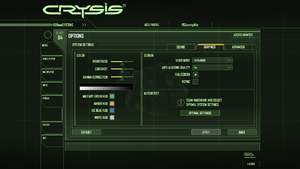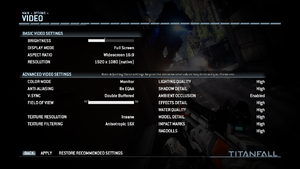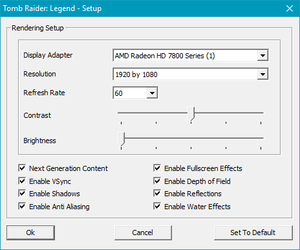PCGamingWiki:Editing guide/Screenshots
An often overlooked aspect of an article, screenshots provide a visual reference for tables and fixes.
Tools
There are countless utilities and programs that provide screen capturing/recording. Which one to use is a matter of preference, but here is a list of the major ones:
- Built-in: Most modern OSes come with rudimentary screen capture utilities or functions built-in. Compared to 3rd party solutions, they are for the most part barebones.
- Windows: Alt+Print Screen & Windows Paint combo, Snipping Tool, Game Bar (Windows 10 only)
- Alt+Print Screen captures the active window only. For the whole screen, use Print Screen.
- Windows 10 has extended functionality with screen capturing. Pressing ⊞ Win+G opens up the Game Bar, allowing for easy screen capture and recording.
- OS X: Grab
- Linux: (Varies between distributions)
- Windows: Alt+Print Screen & Windows Paint combo, Snipping Tool, Game Bar (Windows 10 only)
- Game clients: Most game client software (ex. Steam) include screen capture functionality as part of their in-game overlays. Again, compared to 3rd party programs, the functionality is barebones.
- 3rd party: Standalone utilities and applications that provide screen capturing/recording. Has the most functionality and customization available, but also the most complicated.
Format
There are two ways to insert screenshots into an article: as an embedded file, or as part of a gallery.
Embedded file
Syntax
{{Image|File name|Caption}}
Example
The main method of displaying images on a page. They are normally placed at the top of the relevant section.
Embedded file section breakdown
| Section | Definition | Notes |
|---|---|---|
| File name | The name of the image file. | The file extension must be included. |
| Caption | A sentence or two to identify and describe the image. | See Caption layout. |
Gallery
Syntax (base)
<gallery> --rows go here-- </gallery>
Syntax (row)
File:File name|Caption
Example
In-game general settings for Quake.
In-game general settings for Quake II.
- Quake III Options.jpg
In-game general settings for Quake III Arena.
In-game general settings for Quake 4.
In-game basic general settings for Enemy Territory: Quake Wars.
In-game general settings for Quake Live.
Another method available, reserved mainly for multiple images in a section that would take up too much space as embedded files. They are normally placed at the bottom of the main table for the relevant section.
For the rows, only two sections are present: File name and Caption. Both act in the same manner as the ones included with the embedded files.
Caption layout
The captions for all screenshots of option menus (regardless of format) should follow this model:
<Menu location> <menu specifier (if applicable)> <Name of menu> settings <numbering (if part of series)>.
General rules
- There are 3 types of menu locations:
- In-game: The menu is found while running the game.
- External: The menu is found as part of an external settings program.
- Launcher: The menu is found as part of a game launcher program that must be viewed before starting the game.
- There are 2 types of menu specifiers:
- General
- Advanced
- If a menu cannot be completely captured in one screenshot and stitching them together is not an option, upload the screenshots of the menu as a "series". Add a number to each screenshot to distinguish the ordering.
- "(current #/total #)"
Guidelines
- This section is for visual guidelines. For guidelines relating to technical aspects of screenshots, see PCGamingWiki:Files
- Screenshots should be taken at the native resolution of the monitor.
- For older games that do not support widescreen, set it to the highest possible resolution the monitor can handle (or the game can natively support, whichever comes first).
- Screenshots should show only what the game natively supports. Avoid screenshots of the game with unofficial patches or mods.
- A screenshot should show all the possible options available in that menu.
- If that is not possible (ex. menu is a scrollable list), take multiple screenshots of all the possible options and stitch them together. Some image viewers/editors come with automated functions to do such that (ex. "Create panorama image")
- The look of the UI should be consistent with other related screenshots.
- Ex. If a game is available on both Windows and Linux, all screenshots should be taken from either the Windows or Linux version but not both.
- Ex. 2: If a game supports both keyboard/mouse and gamepads, all screenshots should be taken with keyboard/mouse prompts visible or gamepad prompts visible but not both.
- The cursor should not be visible in the screenshots.
- The cursor can be hidden at the bottom-right corner of the screen.
- If the cursor cannot be hidden completely, move it as far off to the corner as possible.
- For games that have profile systems and the name is visible, use "PCGamingWiki" as the profile name.
- If the system does not support names of such length, alternatives are "PCGameWiki", "PCGWiki", and "PCGW".
- For screenshots of external launchers or options menus, the window border should be visible.
- The window must be also active (i.e. the border is not greyed out).
- Most screen capture utilities allow for the active window to be captured without the background being included.
- On Windows, pressing Alt+Print Screen will capture the active window only.
- If using Windows 8/8.1, the window border needs to be light blue (labeled as "Color 12" under the
Color and Appearancemenu in the Control Panel). This allows the screenshot to match the colour scheme of the wiki, while maintaining high contrast with text. See the screenshot on the right for an example.
- If a screenshot of an external launcher or options menu must include the desktop background (either partially or fully) due to the window styling, set the desktop background to white beforehand.
- All major OSes natively support setting the background to a solid colour via the Control Panel.
- Also make sure that no desktop icons are visible in the screenshot.
- For menus dealing with video settings, max out all the options (or to the limit of the system, whichever comes first) before taking a screenshot.
- This especially needs to be done for games with active menu backgrounds rendered in real time.
- All text in screenshots should preferably be in English.
What are valid screenshots?
- Options menus (external and in-game, as long as they are not junctions for other menus)
- Error messages
- Any application screenshot (only if directly related to a fix)
- Gameplay screenshots (only for comparing video settings like Field of View)
What are invalid screenshots?
- Title screens
- Options menu junctions (menu has no modifiable options, only links to other menus)
- Any screenshot with a personal watermark
- Any screenshot with applications in view that are not directly related to a fix
- Any screenshot with offensive imagery (and is not part of the game)
- Any screenshot that is not original (i.e. taken from another site or person)










